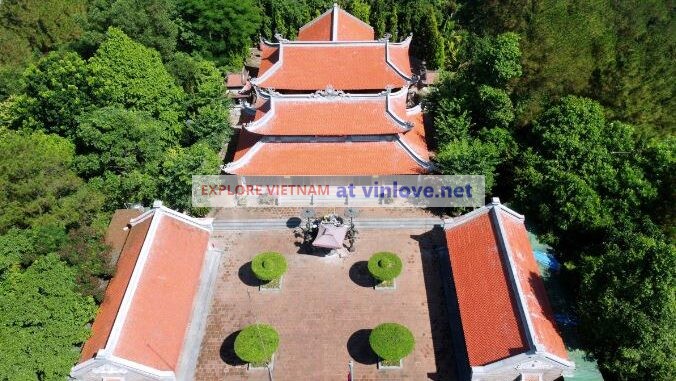
NGHE AN – With the terrain of four spirits, Dung Quyet mountain in Vinh City was once where King Quang Trung built the capital, now his temple here attracts many visitors to visit and worship.

King Quang Trung temple is located on Dung Quyet mountain, Trung Do ward, Vinh city. The mountain has 4 genera, including: dragon head (dragon head), phoenix wing (phoenix wing), Quy Doi (turtle dune) and unicorn, converging all four spirits of Dragon, Lan, Quy and Phung.
Legend has it that after the victory in the spring of Ky Dau 1789, King Quang Trung chose the land to build the capital for the new dynasty in the land between Dung Quyet and Ky Lan mountains.
According to the book “Hoang Le Nhat Thong Chi”, Quang Trung requisitioned a lot of workers, transporting wood, stone, bricks and tiles to build the palace, covering the surrounding earth and sending soldiers to dig local laterite to build the citadel. Inside, building a 3-storey building with two corridors.
When Phuong Hoang Trung Do had just finished building, the plan to move the capital from Phu Xuan (Hue) to Vinh (Nghe An) was unfinished, when King Quang Trung suddenly died. King Quang Toan then succeeded his father, but was usurped by Lord Nguyen Anh. When Nguyen Anh founded the Nguyen Dynasty and established the capital in Hue, Trung Do Phoenix was forgotten. Through the change of time, the building only has a few vestiges left.
To commemorate the merits of the hero Quang Trung, in 2005, Nghe An province built a temple to commemorate him, located on Dung Quyet mountain. The project was inaugurated in 2008, after more than 1,000 days of construction.

From the foot of Dung Quyet mountain, visitors can drive a car, motorbike or walk on a winding mountain road one kilometer long, flanked by pine forests to reach the parking lot. Next is to walk through 81 steps to reach the temple.

In front of the temple is a four-pillar ritual, including a large gate and two small symmetrical gates on both sides, roofed with tiled noses. The large gate is arranged on two floors, with eight roofs made of ironwood in the style of a stack of matches, with two cannons on both sides.


About 10 meters from the main gate, on both sides of the entrance area, the authorities cast dozens of statues of the guardian deity, with the implication to guard the temple.

The architectural highlight of the temple is the front hall, consisting of 3 upper halls, middle halls, and lower halls, designed in the shape of a rising triangle. These three compartments are made of ironwood, carved with motifs, and roofed with tiles.
In front of the front house are two buildings left and right, used to welcome guests and display artifacts. Between the buildings is a 1,500 m2 yard with bonsai garden, creating a fresh and cool space.

In the display house, hundreds of Tay Son artifacts are placed in glass cabinets. Around many ancient paintings are also hung on the wall.

The ancient swords that soldiers of the Tay Son Dynasty used to fight, now rusted, are placed on a red cloth for preservation.

Many rare and precious ceramics from the Tay Son period were also collected and displayed by the competent authorities, contributing to enriching the treasure trove of artifacts.

The upper house is the place to worship King Quang Trung and his father Ho Phi Phuc and his mother Nguyen Thi Dong. Every year, the upper hall is opened on two major holidays: the anniversary of King Quang Trung’s death anniversary on July 29 in the lunar calendar and January 5 – the anniversary of the Ngoc Hoi – Dong Da victory.

The lower house has a worshiping frame arranged according to the worshiping beliefs of the Vietnamese people – pre-Buddhist post-saint. The central hall with three altars, in the middle is the community altar, worshiping the mandarins and generals of the Tay Son period. The left and right sides worship the mandarins and martial mandarins of the Tay Son dynasty.
On weekdays, when people come to visit, they often burn incense and pray at the palace.

In the parking lot area, the authorities arranged a number of stone chairs. At the end of the sightseeing and worshiping journey, visitors can sit and drink water to rest and chat.

Every year, the temple of King Quang Trung welcomes tens of thousands of visitors to sightseeing, pilgrimage and worship. Standing from the temple, you can see the winding Lam River and Vinh City.
